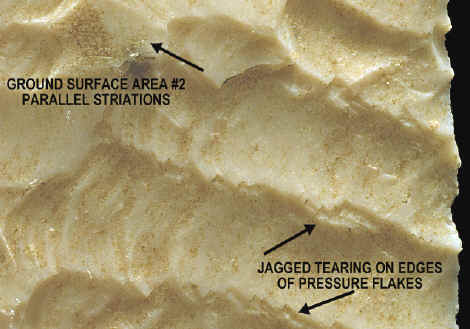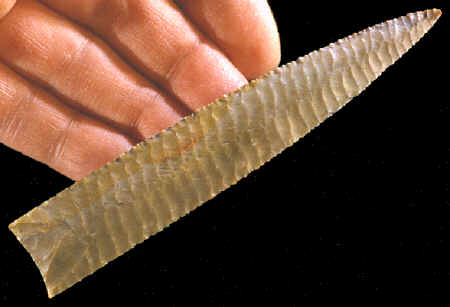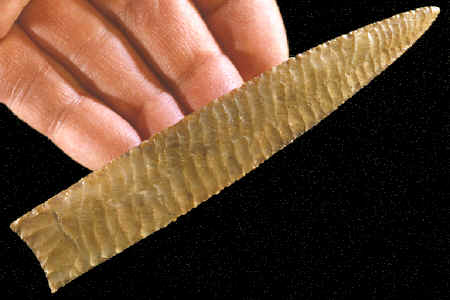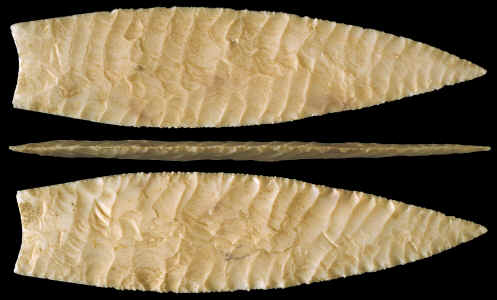|
Richard Warren probably made more "gray
ghost" points than anything else. Larry Nelson reports that "Rich explained that
although he found them ("gray ghosts") boring to make, they
were his bread and butter because rock dealers bought them in
volume." He called them "big ugly spears." Most of his
"gray ghosts" were made out of Texas chert.
|
|

CLICK ON
PICTURE FOR LARGER AREA IMAGE
A POSSIBLE RICHARD WARREN POINT
MAGNIFIED AREAS OF SURFACE
GRINDING & FLAKE TEARING
PRIVATE COLLECTION
This magnified view of the point pictured above illustrates that it
probably was made by "flake-over-grinding" with the use of
some type of lever flaking "machine". One
indication of this is the small areas where the pressure flakes did
not remove all of the original surface. Those surfaces show parallel
grinding marks that were made from
preforms that were ground smooth before they were pressure flaked.
The other indication that this point was made recently is the jagged
edges on some of the pressure flakes. This tearing effect can be caused
by excessive pressure applied by some type of
pressure flaking lever machine. |
|
|
Richard Warren used many different types of stone to
make his points. Larry Nelson reports that Richard was especially fond
of Missouri Burlington chert but Texas chert is also well represented in
the points that he made. When he was in Montana he was using
Porcellanite to make his "gray ghosts". He also used Petrified
Wood from Colorado, Jasper from Wyoming, Rhyolite porphyry from Missouri
and Agate from Oregon.
|
|

CLICK ON
PICTURE FOR LARGE TRIPLE IMAGE
RICHARD
WARREN FLAKE-OVER-GRINDING POINT
PETE BOSTROM COLLECTION
This point is typical of Richard Warren's flake-over-grinding work.
The base is well thinned with several long narrow pressure flakes.
The stone is multi-colored with yellow, red, orange and shades of
brown. It measures 4 11/16 inches (11.9 cm) long. |
|
|
Mr. Warren also made some examples of free form art
pieces. Some of these pieces are described as hollow-center blades and a
mosaic bluebird chipped from colored glass. But these kind of items
didn't sell very well and not many of them were made.
|
|

CLICK ON
PICTURE FOR LARGE TRIPLE IMAGE
RICHARD
WARREN FLAKE-OVER-GRINDING POINT
PETE BOSTROM COLLECTION
This is another good example of Richard Warren's flaking technique.
This point is interesting for the modern patina that has been
applied to it, evidently someone's effort to fool the unsuspecting.
It even has a catalog number KR-2-36 written on one side. This point
is probably made of Texas chert and it measures 4 3/4 inches (12.2
cm) long. |
|
|
Richard Warren also experimented with ceramic points.
He made casts of smoothly ground preforms that he fired in the kiln. He
then flaked them into points. Larry Nelson estimates that Mr. Warren
made a couple of hundred of them.
|
|
CONTINUE ON TO PAGE
THREE
|
|
"REFERENCES"
2002,
Nelson, Larry, "The Richard Warren I Knew", Chips, Vol.
14, #4, pp. 16-18.
|
|
RECENT
LISTINGS HOME
ORDERING |



